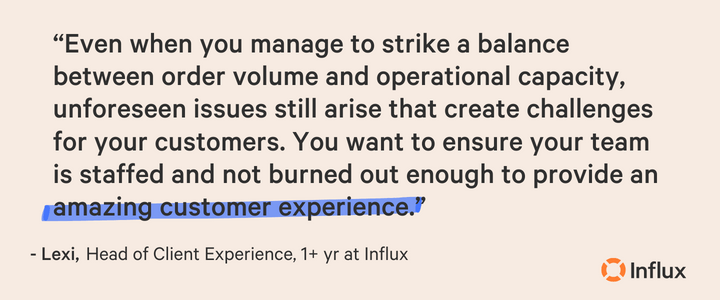Stay ahead of demand and get ready for peak seasons with the simple forecasting calculator. Try the forecasting calculator now →
Maintaining the right number of support agents to match customer support requests is challenging, especially during seasonal fluctuations. Overstaffing is pricey. Understaffing creates backlogs and unhappy customers. Fortunately, there’s a way to find the right balance with a headcount forecasting calculator.
We sat down with Lexi, our Head of Client Experience, to discuss why forecasting is the absolute first step to prepare your customer support team for a successful season. Read the importance of headcount forecasting and how it can help you prepare for a busy season.

What is headcount forecasting?
If you’re a business that experiences a ramp-up of customer support requests during peak seasons, forecasting headcount is for you. But what does it entail? Forecasting headcount predicts a customer support team’s staffing needs based on expected workloads and service level goals. Basically, forecasting headcount allows teams to prepare for a busy season in advance by hiring additional staff if needed, allocating resources, and understanding the staffing requirements to meet customer demands effectively.
When staffing, remember you are putting people on the front lines who will inevitably take the brunt of someone else’s stress. Make sure to create space for your agents to calm them down, and for your agent to process those emotions too!
Why is forecasting the first step to prepare for a busy season?
Forecasting headcount provides essential insights into staffing needs and requirements for handling increased customer support. Without an accurate headcount forecast, businesses risk being understaffed during peak periods, which can lead to longer customer wait times, decreased service quality, and potential customer dissatisfaction. Alternatively, overstaffing can result in unnecessary labor costs.
By starting with headcount forecasting, businesses can make informed decisions about hiring, training, and resource allocation to ensure they have the right number of employees with the necessary skills in place when the busy season arrives. This proactive approach helps maintain customer satisfaction, optimize operational efficiency, and align the workforce with the company’s seasonal objectives. In essence, forecasting headcount sets the foundation for a successful and well-prepared response to increased demand during busy periods.
Use the forecasting calculator to predict headcount and stay prepared!

What do businesses need to forecast headcount?
In our easy-to-use forecasting headcount calculator, we’ve made it simple for you. Just add in these three key numbers:
- Average sales volume
- Average support ticket volume
- Expected sales volume
Using historical data helps to identify seasonal variations, staffing levels, and workloads.

Forecasting is a valuable staffing tool, but it can’t predict your customers. It’s important to have a strategy for how you’ll adapt to a higher or lower support demand. In the event of higher demand, where your internal team is overwhelmed by inquiries, we’d like to extend a helping hand and offer a customized solution to help you keep the backlog under control and reach more customers.
Grow your business faster with fully flexible month-to-month support teams. Whether you need after-hours, burst coverage, or global 24/7 support, we’re ready to help you respond to customers faster with all management and training included. Launch in one week without the long-term commitments.
Ready for an extra layer of coverage you can dial up (or down)? Let’s talk!

